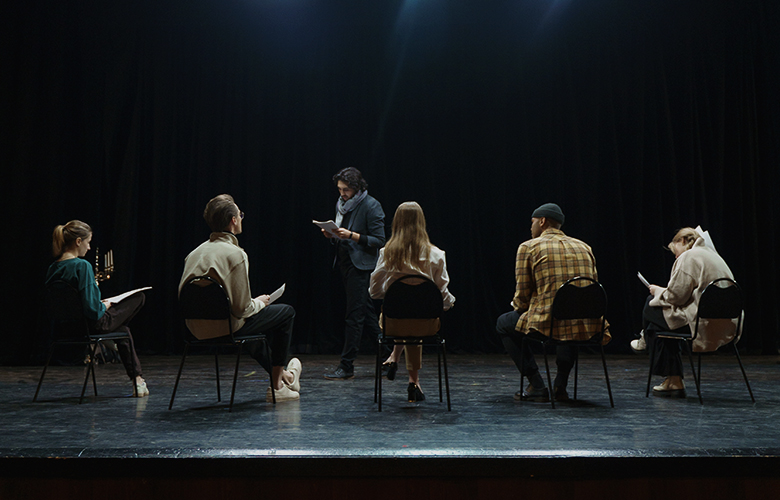
After thirty years of presenting entertainment at corporate events, I, like many others in my field, have had to adapt to the rapidly changing landscape of virtual production. The changes have asked much of me. Here are my current preoccupations on an industry transformed overnight by our pandemic-driven mutable world.
For a variety of reasons, many entertainers find it a considerable challenge to accommodate new virtual event realities. To begin with, they all have to adapt to a new asymmetrical bond with a remote audience, one where they cannot see the whites of their eyes. Other challenges include: How do they keep performance standards up that were once so driven by the power of audience response? Under the pressure of lost revenue, how do they quickly create and develop a virtual repertoire for a broadcast format? And, finally, with performances and rehearsals cancelled how do entertainers with special skills stay sharp and not fall flat?
I see the “once-was-world” of my client base now grappling with new demands made by bosses, boards of directors, and strategic partners. In order to feel confident before signing contracts, event professionals want to see how the talent, be it a headliner or opening act, has previously performed in a virtual setting. And budgetary concerns, as usual, are also on the table: what should one pay for virtual performances typically much shorter in length and without the complexities of a live performance. In addition, production timelines are mercurial because the decision-making of key stakeholders is more involved. As if this isn’t enough, sequencing of performances throughout the program is extra critical: balancing the placement of entertainment highlights with keynote speakers, the agenda at-hand, and networking.
The old captive audience – the one congregating in convention centres and ballrooms – has left the building. They are now the new captive audience, but, paradoxically, freer than ever before. Deprived of social interaction, we all know that viewer attendees, for any reason, may at any time leave the screen. Perhaps all of us in this position must try to be more patient and attentive and extend this generosity in a new way to support artists, presenters, and production teams. That is, as members of a virtual audience we will be often be asked to participate with the entertainment through technologically-supported Q & A and chat functions, not to mention appearing on screen ourselves and becoming part of the show!
At Carol Priest Entertainment, like a dancer or athlete who pivots, our home foot is firmly grounded in “live” while our other foot stretches, responding to demands in a new-world of hybrid and digital performances. Yet it goes without saying that we are more social than our current captivity, and while the virtual footprint is here to stay it will always be but a shadow of our public celebratory humanity when it once again assembles in venues where the impact of the artist makes our spirit rise like the bubbles in a glass of champagne.
Carol Priest
Director / Producer / Agent/ Entertainment solopreneur since 1991.
Carol Priest, CPE
cp@carolpriestentertainment.com
Adrian Angelico: A Virtuoso Trans Male Opera Singer
James “Fitz” FitzSimmons Interview: The Boys In The Band On Netflix


Carol Priest is an Entertainment Specialist with a flare for putting the wow into corporate and special events. As Founder and Creative Director of Carol Priest Entertainment (CPE), she has produced hundreds of bold and imaginative entertainments for companies across North America. In 2021 , Carol Priest was awarded the Leslee Bell Lifetime Achievement Award from the International Live Events Association, along with being noted by Biz Bash, as The Top 250 Go-To Event Profs. in Canada. In 2019, her company CPE was a finalist for Best Entertainment Production by Canadian Special Events. She was inducted into the Meetings & Incentive Travel Hall of Fame in 2017. and in 2016, CPE, was chosen as The Canadian Special Events, ' Favourite Entertainment Company.' In 2011, her entertainment savvy was recognized in the book ‘Reflections of a Successful Wall Flower‘ by North America’s pre-eminent event producer Andrea Michaels. And in 2003, her special event work for Goldcorp Inc. was featured in Maclean’s Magazine. She has been the recipient of a Theatre Ontario grant where she studied theatre production with Brian Sewell, who is now Executive Producer for Mirvish Productions. After this wonderful opportunity, she expanded her skill set and went on to manage the Specialty Entertainment Division of Noble Talent: working on Film, TV & Commercial projects. In 1987, Carol joined Showmakers Inc., where she was mentored by Producer, Taras Shipowick. She worked on prestigious events such as ‘The Brazilian Ball‘, The Canadian premiere of ‘The Phantom of the Opera‘, and ‘The 100the anniversary of Maclean Hunter
Read Full Profile© 2021 TheatreArtLife. All rights reserved.

Thank you so much for reading, but you have now reached your free article limit for this month.
Our contributors are currently writing more articles for you to enjoy.
To keep reading, all you have to do is become a subscriber and then you can read unlimited articles anytime.
Your investment will help us continue to ignite connections across the globe in live entertainment and build this community for industry professionals.